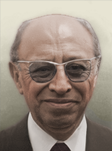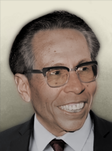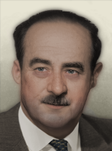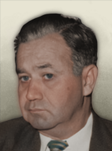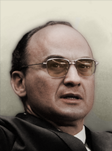Institutional Revolutionary Party
The Institutional Revolutionary Party (Partido Revolucionario Institucional) is the dominant political party in Mexico, currently led by President Adolfo López Mateos and Alfonso Corona del Rosal. It was founded in 1929, under the name National Revolutionary Party (Partido Nacional Revolucionario).
History
The predecessor to the PRI was founded in 1929 in the aftermath of the Mexican Revolution by General Plutarco Elias Calles, the party was meant to act as a bridge between the federal government and the numerous revolutionary caudillos that controlled most of Mexico in the 1920s, the caudillos were united under one party to attempt to prevent any further coup attempts which during the period ocurred on a yearly basis. As a part of this goal the PNR was designed to entrench the power of former president Calles as he wielded it to dominate the presidents of Mexico that followed him, establishing a regime known as the Maximato.
As the PNR engaged in nation building however it began gearing towards securing the goodwill of the large Mexican public, gradually President Lazaro Cardenas del Rio suceeded in steering the party away from Calles culminating in a popular coup in 1935 leading to his exile and later arrest. President Cardenas used the PNR to unite the disunited worker syndicates of Mexico and the nearly nonexistent agrarian leagues, this titanic effort lasted years and culminated in 1938 with the dissolution of the PNR and establishment of the PRM (Party of the Mexican Revolution), the PRM established that same year a corporatist system which divided Mexico into 4 sectors for the party and gave each sector a corporation that would represent them within the PRM. During this period the PRM moved towards overt socialism with large scale nationalizations and expropiations of mineral and commercial resources, combined with new education, welfare and anti clerical policies.
The presidency of Lazaro Cardenas del Rio ended with the 1940 election, this election was extremely contentious as the flourishing PRM party state failed to fall in line with Cardenas desired succesor, leading to the first of many schisms and a deeply violent election cycle as the opposition had to be violently repressed, what followed Lazaro Cardenas was the presidency of Manuel Avila Camacho. His presidency saw a overhaul to the PRM corporatist system as it removed one sector (the Armed Forces) and established the vaguely defined popular sector as a counterweight to the overwhelmingly leftist Cardenista CTM.
Manuel Camacho firmly moved the PRM to the right, using the Second World War and the rise of fascism as a excuse to establish social dissolution laws and severely halting land reform and most of the overtly socialist policies of the previous presidency, these decisions were designed to move the PRM away from socialism and towards acting as a electoral machine for the ruling president and his desires. Finally in the last year of his presidency, Camacho once again renamed the PRM, establishing the Revolutionary Institutional Party (PRI - Insert link) on the year 1946.
The first PRI president, Miguel Aleman faced numerous challenges to his government. Large sections of the Party protested what they saw as a abandonment of revolutionary values for increasingly technocratic policies, this was compounded by Aleman forsaking the traditional rural focus of the Party in exchange for a heavy focus on rapid industrialization.
This focus on rapid industrialization brought great changes to the party as it broke with independent union activism and secured the CTM and CNC as allies to their self interest, the party opened up to foreign donations and alliances with domestic and foreign industrialists. This new wave of corrupt industrialism led to once again another schism in 1952 led by the leftist revolutionary general Miguel Henriquez Guzman, almost ending in a coup by the Henriquistas in 1953. This schism threatened the party itself and led to major changes to the political status quo, chiefly the introduction of tapadismo as a method of succesion.
Troughout the 50s under the presidencies of Adolfo Ruiz Cortines and Adolfo Lopez Mateos, the PRI has become a much more centralized institution which follows the theory of tapadismo, the President chooses his own succesor as multiple candidates fight for his favor. This theory has stabilized the PRI and ended the schisms that ocurred every transition of power.
As the Mexican Miracle of the 1950s and 1960s continues, the party is now compromised of multiple interest groups often complaining to the presidency and the National Executive Committee, but above all if the PRI prioritizes something, it is unity in the eyes of the public and a strong presidentialist regime that ensures absolute control over national politics. It is trough this combination of unity, repression and generous populist handouts that the PRI can truly be called the "Perfect Dictatorship".
Situation in 1962
The PRI in 1962 has seeming absolute control over Mexico, being a decade away from any schism whatsoever, and with about half of the Mexican population being involved in organizations related to the PRI with a membership of over 10 million Mexicans. However the PRI is faced with the 1960s being the last decade for most of the surviving politicians of the Revolution, with most of them dying off in the early to mid 1970s.
As the decade starts however, reformist movements have begun picking up steam after close to 2 decades of PRI orthodoxy. On one side the dissastified Cardenistas seek to recover the power they once held in the mid to late 1930s, while the Alemanistas are broadly satisfied with the national direction but still desire a rapid radical shift towards the right wing mirroring the Aleman presidency.
While these bickering and internal instability could damage the party, for now it is in a true golden era with the leadership falling to complacency as they feel finally secured in their power against internal and external threats.
Organizations
These are the organizations that are outside the PRI officially but are located within it´s internal structure.
Confederation of Mexican Workers
The CTM is the most formidable organization in Mexico outside of the PRI itself, led by the widely feared Fidel Velasquez who is also considered by some to be the most powerful man in the country, or at least the second most powerful second to the president himself. The CTM controls the labor sector of Mexico with a iron fist, from electricians to factory workers to telegraph operators they all have to be part of the organization and pay their dues to it in order to have a future in the economy. The men who lead the CTM are titans and while the millions under their control may be disastified or grumble, none dare challenge them least they face the terrible fate of the strikers in 1958/1959.
Being the organization that brought Charrismo to the national ecosystem, the once deeply ideological socialist organization has become a echo of what it used to be, now it is a pragmatic conglomerate designed to profit and expand careers for the leadership trough working with those with deep pockets in the party and the industrialists.
Not just wealthy, the CTM holds great power nationwide and can challenge and bring the PRI to it´s knees if forced, while it is the only organization which can permit strikes alongside the government, this great power used to crush strikes can be turned right on the government if one were to anger the leadership and it mobilized the dozens of confederations and unions under it´s wing, such a event could occur through threatening the bottom financial line, through moving in a undesireable ideological direction, or through changing the System of Quotas created to give the Corporations representation in congress and the party in exchange for not seeking national leadership. All of these factors could bring the delicate house of cards down.
National Peasant Confederation
The CNC is the second largest corporation in Mexico, by some metrics it has even more members than the CTM but it pales in comparison to the power of the CTM and even the CNOP, the CNC is lead by Francisco Hernández y Hernández in 1962.
While the CNC was formed only 2 years after the CTM, the history behind it´s formation could not be more different, the CTM had 15 years of organizing behind it´s formation by independent union activists from all across the political and partisan spectrum of the time. Meanwhile prior to the CNCs formation there was no independent organizing, the agrarian leagues even if they were the driving force behind the Revolution for the most part crumbled beyond local municipalities, the federal government under President Lazaro Cardenas del Rio in 1936 began a plan to unite them into one confederation, it was not organic and in the long term facilitated the destruction of peasant representation as they were subjugated to political desires from the very start, while this was done with good intentions by Cardenas as he had a paternalistic view on the peasantry, this subjugation would quickly turn the CNC into a government toadie during his presidency. Something which has only continued since then.
While the CNC is strong on it´s own and is able to cause chaos if aroused, it is extremely loyal to the party orthodoxy and is for the most part incapable of independent action like the CTM, with it´s leadership coming and going without time to consolidate power unlike the seemingly eternal Fidel Velasquez. Despite it´s weakness one should not dismiss the CNC, for it has the capacity to mobilize millions of peasants across the country and is a key section of the PRI state apparatus.
National Confederation of Popular Organizations
Compared to the other two great corporations, the CNOP has a slightly different history. A late addition to the system as it was formed trough the reforms of Manuel Avila Camacho in the year 1943, it was formed in the context of reforms meant to remove ideology from the PRM and to counteract the at the time still heavily socialist CTM. In 1940 the military sector was disbanded, and in 1943 the Federal Employee sector was replaced with the Popular Sector to broaden the power of the party while at the same time building a new less ideological base.
While in CTM and CNC PRI membership is mandatory to participate, the CNOP is unique in that it is officially a part of the PRI, though it acts as a organization within it rather than a direct part of the party structure.
While the CNOP is powerful and extremely large, it is extremely disorganized and has no clear leadership, the popular sector encompasses everything from doctors, to female workers, to cleaning crews to teachers and professionals and by design controls these groups through not permitting them to mobilize without first shaking up the gigantic structure.
Popular Socialist Party
The PPS is perhaps one of the greatest symbols of PRI supremacy in modern day Mexico, it is one of the 4 legally permitted parties in Mexico that is allowed to contest elections, though it does so in a coalition alongside the PRI where they postulate the PRI candidate while in exchange receiving a pittance in seats in the house of deputies with no governorships or senate seats.
As such the PPS is considered a "Paraestatal" alongside the PARM, while more ideological than PARM or party orthodoxy, it will obey the every move of the PRI if it wants to retain it´s status as the most left wing party legally permitted to exist.
Party of the Authentic Mexican Revolution
The PARM is one of 4 legally permitted parties in Mexico that is allowed to contest elections, not much is remarkable about it aside from it´s absolute loyalty to the PRI, but unlike the PPS it has no rebellious streak or ideology other than a center left leaning. It is one of two Paraestatal parties in Mexico.
Factions
PRI Old Guard
The PRI Old Guard is known by many different names, this is the establishment of the party and the most orthodox section. Contrary to some expectations the Old Guard does have a ideology outside of opportunism and the desire to hold onto power, it has a desire to keep a strong independent Mexico in the face of foreign powers, it usually supports agrarian politics even if they are willing to adopt the industrialization of the Alemanista faction, and more importantly they believe in economic and revolutionary nationalism. This segment of the party is the most powerful and is full of the men that have controlled Mexico ever since the Revolution.
Members
- Adolfo López Mateos - President of Mexico
- Alfonso Corona del Rosal - President of the National Executive Committee of the Institutional Revolutionary Party
- Gustavo Díaz Ordaz - Secretary of Interior
- Fidel Velasquez - General Secretary of the Confederation of Mexican Workers
- Agustin Avila Olachea - Secretary of National Defense
- Marcelino Garcia Barragan - General
- Manuel Tello Barraud - Secretary of External Relations
- Luis Echeverria Alvarez - Sub secretary of Interior
- Adolfo Ruiz Cortines - President of Mexico (1952-1958)
- Leopoldo Celis Sanchez - Governor of Sinaloa
- Praxedes Giner Duran - Governor of Chihuaha
- Alfonso Martínez Domínguez - Speaker of Congress
- Blas Chumacero Sanchez - Congressman of Puebla
- Javier Rojo Gomez - General Secretary of CNC
Alemanistas
The Alemanistas, also known as the Technocrats are the right-wing of the party, while they may not believe in the legacy of the Revolution or in full economic nationalism, for years they have constructed a image compatible with the party´s values while emphasizing the policies of President Miguel Aleman Valdes.
Members
- Raúl Salinas Lozano - Secretary of Industry and Commerce
- Octaviano Campos Salas - Economic Advisor to Secretary of Industry and Commerce
- Antonio Ortiz Mena - Secretary of Hacienda and Public Credit
- Ernesto Peralta Uruchurtu - Head of the Department of the Federal District
- Miguel Aleman Valdes - Former president of Mexico (1946-1952)
Cardenistas
The Cardenistas, often called the Reformists of the party are the left-wing of the party, they are the most ardent believers in the values of the revolution and often advocate for a return to the socialist roots of the party during the presidency of Lazaro Cardenas, they are the most vocal wing of the party but still remain loyal and cowered by the Old Guard.
Members
- Carlos Alberto Madrazo - Governor of Tabasco
- Javier Barros Sierra - Secretary of Public Works
- Lazaro Cardenas del Rio - Former president of Mexico (1934-1940)
- Vicente Lombardo Toledano - Former General Secretary of CTM (1936-1941)
- Miguel Henriquez Guzman - Former General and presidential candidate of PCCM
- Emilio Martinez Manatou - Secretary of the Presidency
The important faces of the PRI
Adolfo López Mateos
The current president of the ***United Mexican States***, as president he is the most important man in the party and in the country, his wish is the command of every party member and the party follows his ideology and standard. The current president is a half-hearted return to the past, a era of leftist ideology and heart and good will and he has been enormously succesfull for the party, even if the example he sets can only be followed for so long.
In game, he is president until december of 1964 and will serve as the introduction to Mexico content.
Alfonso Corona del Rosal
General Del Rosal is a man of honor and technically the most important man in the PRI. He is president of the National Executive Committee of the Party and thus holds authority over every member and militant in Mexico, however while in practice he still obeys the president and the powers above of the CTM, he still is a very powerful man on his own both in civilian government and in the military who one day seeks to reach the highest position in the land.
He will alongside Ordaz try to work to keep the Old Guard of the PRI in power while increasing his own hold over the party he leads.
Gustavo Díaz Ordaz
Ordaz is a cold man with few allies and even fewer friends but he is indispensable to the party and it´s health, for years he has been considered "the one" to the party even if the president may not always agree with that conclusion. His grip over the party is strong and will only grow stronger if he successfully reaches the presidency.
Ordaz will head the old guard for the PRI and the player will be able to place him on top as the next president of Mexico.
Fidel Velasquez
A great eminence on his own, usually it is hard to impossible to blame institutional corruption and rot on a single man or group of men, to call someone the center of the rot that afflicts a institution, but in PRI Mexico if someone comes close to fulfilling that role then it is Fidel Velasquez, a powerhouse that bends the PRI to his will as even the president is forced to listen to his advice.
For the first 2 years of the game Fidel Velasquez works in the background to maintain his power, it is not until the initial presidency ends that he can start making true moves.
Raúl Salinas Lozano
A quiet workhorse that in public does not stand out, but behind close doors has been building for decades a impressive network of favors, patrons and allies. But as the men above him make mistakes and compromise their position he continues to work, usurping their power day by day until the time to strike comes.
As the leader of the technocratic faction, Salinas will compete for the attention of Lopez Mateos and set the stage for a new technocratic presidency.
Antonio Ortiz Mena
[[File:Portrait_MEX_Antonio_Ortiz_Mena.png|thumb|151x151px|Mena's portrait] The architect of the Mexican Miracle and one of the most renowned economists of the 1960s, Ortiz Mena has attracted plenty of international and domestic attention for his exploits as the head of the Secretary of Hacienda and Public Credit, he will generally avoid the spotlight, but few deny his notoriety could prove to be a great asset to the Alemanistas.
Carlos Alberto Madrazo
The "Cyclone of the South" is a explosive man known for his charisma and his tough ideological stance, while he is away from the politics of Mexico City. He will do his upmost to keep Ordaz and the Technocrats in check by advocating for measures that return to what he sees as the soul of the party, for much of the early game he is mostly a annoyance, that is until his enemies make enough mistakes.
Luis Echeverria Alvarez
A quick up and comer to the party, Echeverria has devoted most of his life and his entire adult life to the PRI, rising trough positions in security and interior over the years he now serves as Under-Secretary of Interior, second only to Ordaz himself. He will work with Ordaz and potentially Madrazo to secure PRI party orthodoxy, even if it does not quite align with his beliefs.


